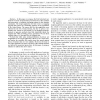Free Online Productivity Tools
i2Speak
i2Symbol
i2OCR
iTex2Img
iWeb2Print
iWeb2Shot
i2Type
iPdf2Split
iPdf2Merge
i2Bopomofo
i2Arabic
i2Style
i2Image
i2PDF
iLatex2Rtf
Sci2ools
192
Voted
ICDE
2008
IEEE
2008
IEEE
Privacy: Theory meets Practice on the Map
In this paper, we propose the first formal privacy analysis of a data anonymization process known as the synthetic data generation, a technique becoming popular in the statistics community. The target application for this work is a mapping program that shows the commuting patterns of the population of the United States. The source data for this application were collected by the U.S. Census Bureau, but due to privacy constraints, they cannot be used directly by the mapping program. Instead, we generate synthetic data that statistically mimic the original data while providing privacy guarantees. We use these synthetic data as a surrogate for the original data. We find that while some existing definitions of privacy are inapplicable to our target application, others are too conservative and render the synthetic data useless since they guard against privacy breaches that are very unlikely. Moreover, the data in our target application is sparse, and none of the existing solutions are tailor...
| Added | 01 Nov 2009 |
| Updated | 01 Nov 2009 |
| Type | Conference |
| Year | 2008 |
| Where | ICDE |
| Authors | Ashwin Machanavajjhala, Daniel Kifer, John M. Abowd, Johannes Gehrke, Lars Vilhuber |
Comments (0)

